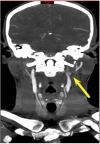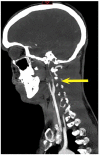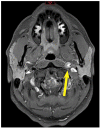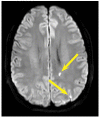Cervical Artery Dissection and Choosing Appropriate Therapy
- PMID: 29849298
- PMCID: PMC5965176
- DOI: 10.5811/cpcem.2017.3.33296
Cervical Artery Dissection and Choosing Appropriate Therapy
Abstract
Cervical artery dissection is a common cause of stroke in young adults. This may result from head and neck trauma; it can also occur spontaneously or secondary to genetic connective tissue or vascular disorders. Neurologic symptoms arise as a result of thromboembolism and hypoperfusion causing cerebral ischemia. We present a case of a previously healthy male who was found to have a cervical internal carotid artery dissection and the decision to use antiplatelet therapy instead of anticoagulation to prevent stroke. Data is lacking regarding the efficacy of one therapy over the other.
Conflict of interest statement
Conflicts of Interest: By the CPC-EM article submission agreement, all authors are required to disclose all affiliations, funding sources and financial or management relationships that could be perceived as potential sources of bias. John S. Hunt, MD, discloses the following: “I retain no rights to the article. I have no financial interest in the drugs, devises or procedures described in the forgoing article.”
Figures




References
-
- Lee VH, Brown RD, Jr, Mandrekar JN, et al. Incidence and outcome of cervical artery dissection: a population-based study. Neurology. 2006;67(10):1809. - PubMed
-
- de Bray JM, Marc G, Pautot V, et al. Fibromuscular dysplasia may herald symptomatic recurrence of cervical artery dissection. Cerebrovasc Diseases. 2007;23(5–6):448. - PubMed
-
- Ji R, Schwamm LH, Pervez MA, et al. Ischemic stroke and transient ischemic attack in young adults: risk factors, diagnostic yield, neuroimaging, and thrombolysis. JAMA Neurology. 2013 Jan;70(1):51–7. - PubMed
-
- Mitsias P, Ramadan NM. Headache in ischemic cerebrovascular disease. Part I: Clinical features. Cephalalgia. 1992;12(5):269. - PubMed
Publication types
LinkOut - more resources
Full Text Sources
Other Literature Sources
